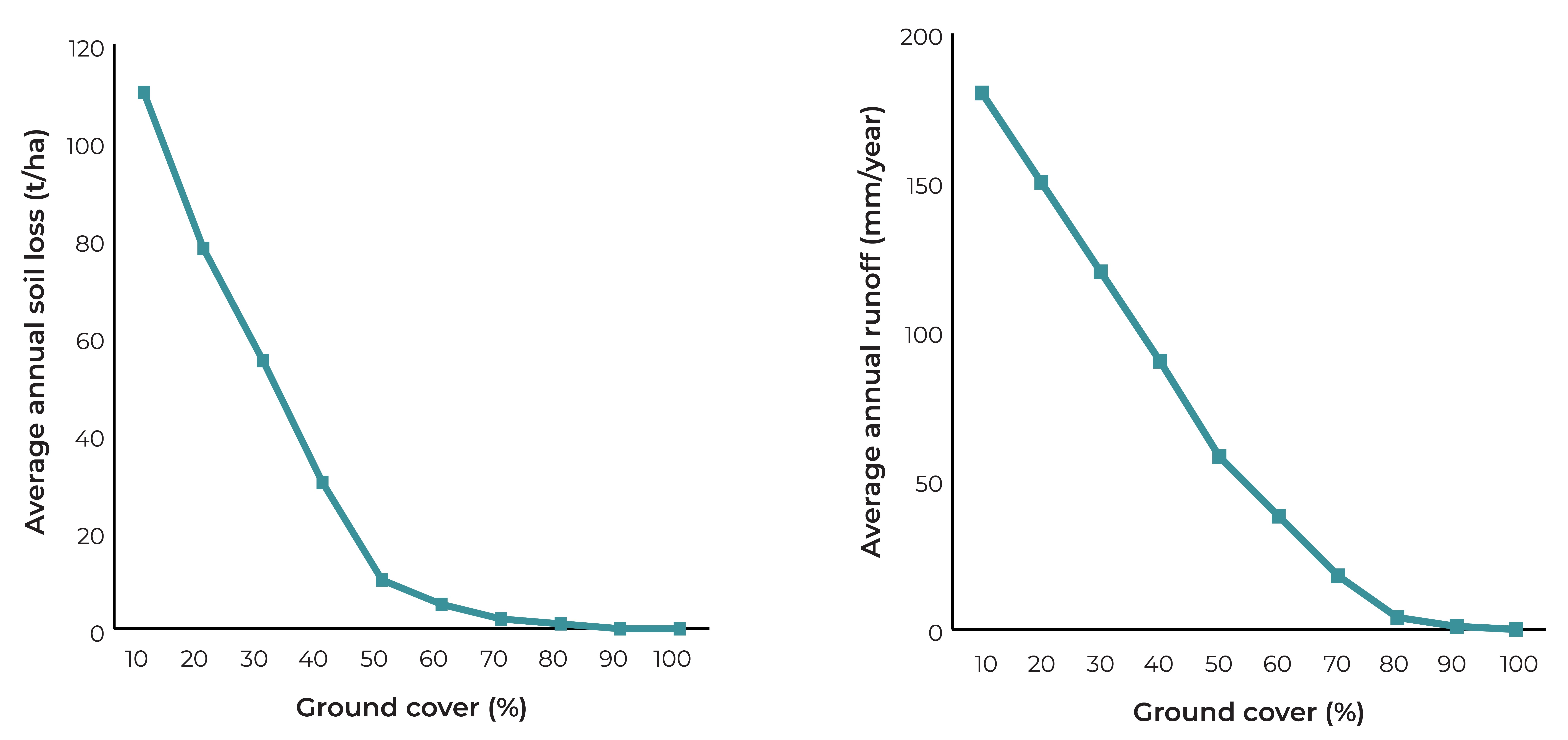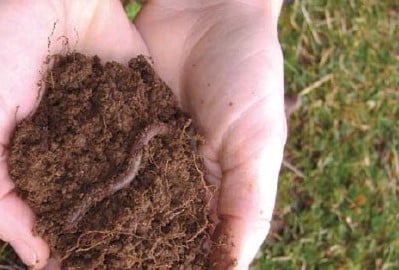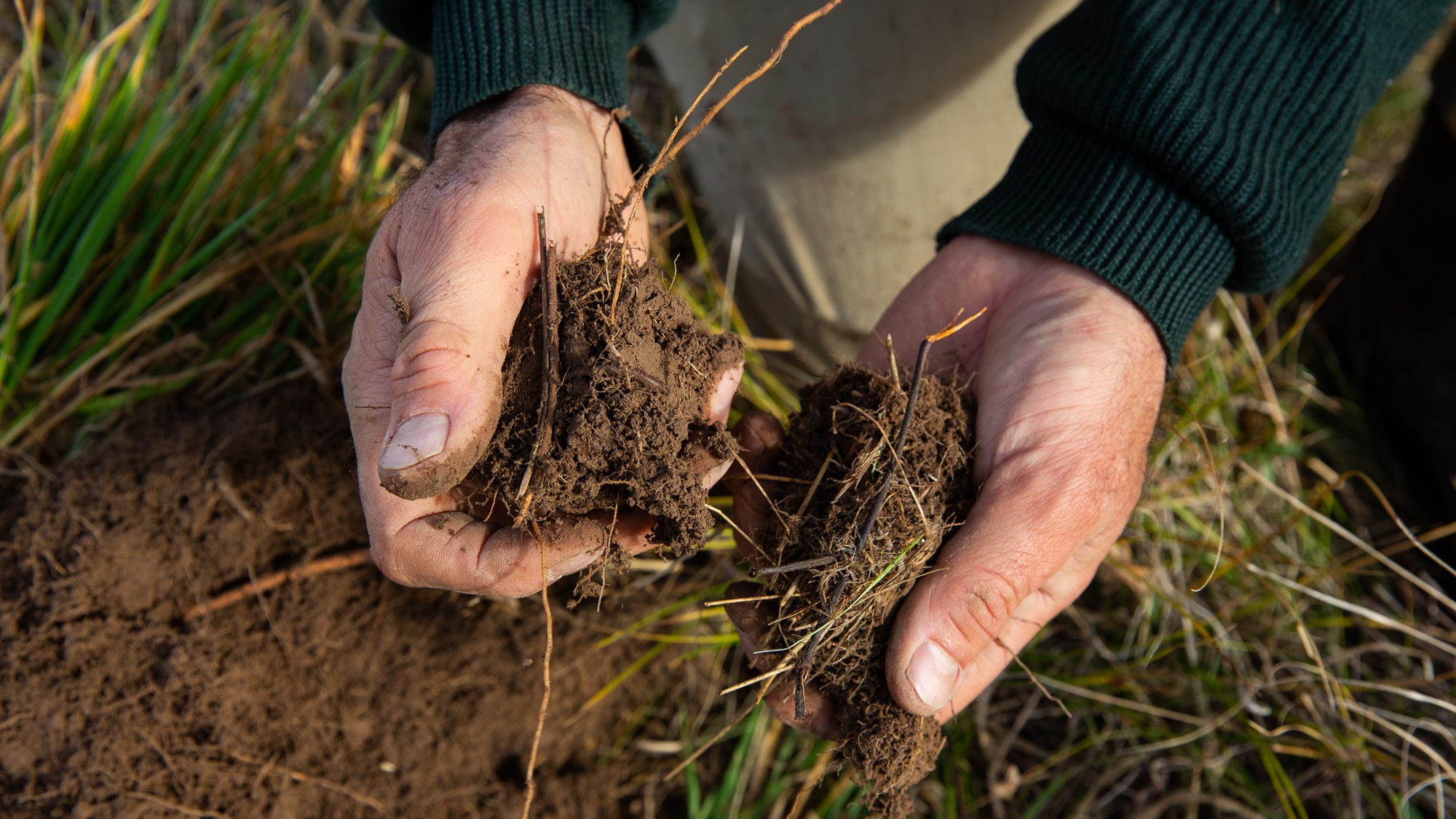Chapter 6.2 Maintain groundcover to enhance soil health and promote biodiversity
Background information
The top 10 centimetres of most soils is a precious, non-renewable resource, containing most of the soil’s nutrients, plant roots and living organisms (bacteria, fungi, protozoa, nematodes, earthworms and other soil animals). Soil biota represents a large portion of the earth’s biodiversity.
Soil bugs are living organisms and thus requires a food source, air, water, shelter and a stable environment. Groundcover and litter assists soil biology by maintaining a more stable temperature environment, lessening temperature fluctuations and provides shelter. Groundcover levels can also be important in weed control, particularly for thistles and Paterson’s curse, and for reducing the impact of root feeding grubs such as cockchafers and scarabs.
At a glance
- Maintain groundcover to protect soil from erosion and minimise water loss and provide a sustainable environment for soil fauna.
- Assess groundcover and litter levels at key times and give your soils the ‘look, feel and smell’ test.
In a pasture system, grazing animals account for only about 25% of the living animal tissue in the system. The rest is accounted for by bugs that live in the soil and litter (decomposing plant material that lies on the soil surface). The activity of bugs and earthworms that feed on soil organic matter and recycle nutrients, also helps to improve soil structure and water holding capacity, allowing rainfall to penetrate the soil and be available for plants. Healthy biodiversity in soil organisms is also important for suppressing pathogens which cause root disease.
All of the biological ‘action’ in the soil relies on providing food together with suitable temperature and moisture conditions. By far the most critical management action which sheep producers can take to protect their soils and ‘keep the soil bugs happy’ is to maintain high levels of groundcover. This is provided by litter, as well as growing and dead plants. The standard benchmark is 70% groundcover (see figure 6.1 and Tool 6.2).
Maintain groundcover
Groundcover protects soil, encourages microbial activity and increases water holding capacity in soils. A minimum of 70% groundcover is the accepted benchmark for high rainfall zones except for sloping country where close to 100% is needed. For semi-arid areas (200-300 mm) a minimum of 40% is targeted.
Soil organic matter levels are mainly influenced by climate and soil type (as they are main drivers of plant growth), erosion, cultivation and fertility, making it almost impossible to set target levels, but for soil health, more is always better. As a general rule, targets are greater than 2% in low rainfall environments and 3% in high rainfall. Generally, woodland maintains higher organic matter than pastures and pastures are higher than land cultivated for crops. Chapter 8.2 in MMFS Module 8 Turn Pasture into Product has tips for maintaining groundcover with grazing.
One millimetre of topsoil lost by erosion equals about 10 tonnes of soil per hectare. Depending on your soil type and history, this could represent a loss equivalent to 130 kg/ha organic carbon, 20 kg/ha nitrogen (40 kg/ha urea), 8 kg/ha phosphorus (100 kg/ha single super). Soil can take thousands of years to be replaced through the weathering of parent material. Therefore, protecting your soil asset by maintaining groundcover is critical. Where topsoil has been lost through erosion, the only way to restore some of the productive capacity is by building up organic matter from plant and animal residues.
Rainfall erosion is most likely to occur during heavy rainfall events when you have low groundcover. Groundcover (litter and plants), as well as being a forage source, minimises raindrop impact and loss of water by runoff (figure 6.1) and decreases wind speed across the paddock, reducing soil erosion and nutrient loss. Litter on the soil surface can reduce evaporation by up to 1 mm per day. Wind erosion is most likely to occur during drought or dry seasonal conditions.

Figure 6.1 In the medium to high rainfall zones of eastern Australia, maintaining 70% groundcover can minimise both soil loss and run-off.
Source: Pasture management for both production and stability, Lang, RD (1998). Adapted by AWI.
Attracting good soil bugs
Litter (or mulch) not only helps protect the soil from wind, rain and temperature extremes, it is also the main food source for soil organisms. Litter quality is just as important for the bugs as pasture quality is for grazing animals. Highly digestible, high protein feed is readily consumed and the nutrients recycled but it takes much longer for dead, fibrous stems and leaves to break down and be recycled. When the bugs die, nutrients (such as nitrogen, phosphorus, potassium, and sulphur) are released and become available again for plant growth.
Increasing soil fertility generally increases both pasture growth and quality, which leads to more and better quality litter and, therefore, more of the ‘good soil bugs’ with increased activity.
Earthworms are a good indicator that soil conditions are suitable for microorganisms. Sample moist soil at the end of winter or early spring. In the high rainfall zone, more than 10 earthworms per spadeful (20 cm by 20 cm by 10 cm deep) is equivalent to a stocking rate of more than 2.5 million earthworms per hectare and indicates an active biological system.
A healthy and functioning soil ecosystem contains a wide diversity of soil organisms. Diversity is indicated by being able to observe or count more than six different species of soil organisms in a spadeful of soil. An earthy smell is also a good indicator as this suggests active and healthy actinomycetes (beneficial soil bacteria).

Source: Susan Orgill, NSW DPI
Figure 6.2 Earthworms are a good indicator that soil conditions are suitable for microorganisms.
Soil conditions that reduce soil biology
Many factors can reduce soil biology:
- Soil temperatures above 25°C or below 15°C: it is impossible to keep the soil temperature always in this range, but a good litter layer can help.
- Dryness: most soil micro-organisms live permanently in the water film around soil particles and like their food moist.
- Regular cultivation: physically disturbs the soil and reduces soil microbe levels by decreasing aggregate stability and depleting organic matter.
- Overgrazing and compaction: reduce soil health and can starve the bugs of much needed food, reducing their activity and therefore the rate at which nutrients are recycled.
- Burning: destroys litter and reduces inputs of soil organic matter.
- Waterlogging: can reduce the oxygen content of soil, slowing the rate of organic matter decomposition. This can be caused by compaction by grazing, cultivating wet soils or sodicity.
- Acid soils: like plants, the preferred range for most microorganisms is pH (CaCl) 5.5 to 6.5.
- Some chemicals: herbicides generally have less impact on soil organisms than insecticides, which, in turn, are less harmful than fungicides and nematicides. Most microbes tolerate herbicides with few persistent effects. However, simazine, 2,4-D, paraquat, diquat and MCPA can be more harmful than glyphosate and sulphonylurea. Anti-parasitic drenches can have an adverse effect on organisms that first colonise affected dung.
SIGNPOSTS
READ
(2016). G. Stirling, H. Hayden, T. Pattison, M. Stirling
(2003). L.K. Abbott and D.V. Murphy
(2005). R.D. Bardgett
Healthy, fertile soils drive pasture productivity and deliver environmental benefits through improved water and nutrient use with less risk of surface run-off, erosion and deep drainage.
Multiple fact sheets covering concepts of soil biology, including building organic carbon, encouraging soil organisms and biology testing.
Find out more about the living things in soil and what they do.
Dung beetles play a critical role in Australia’s grazing ecosystems. By burying dung in the soil, beetles improve the flow of water, nutrients and carbon into the root zones of pastures.
The adverse effects of some parasite control products can include death of adult beetles, eggs or larvae, reduced breeding capacity of adults and retarded growth of larvae. Heavy chemical may lead to local extinction of some dung beetle species.
USE
Use satellite imagery to provide weekly pasture biomass and groundcover levels.
Use the tools on this website to better understand soil health.
ATTEND
A rapid assessment of pasture condition using a quadrat and decision guide. Includes assessment of groundcover and litter.






